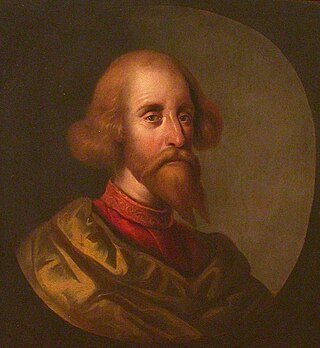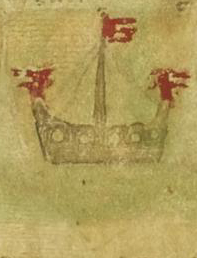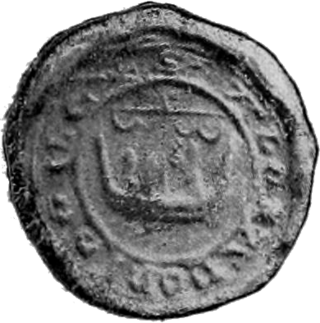
Cuilén was an early King of Alba (Scotland). He was a son of Illulb mac Custantín, King of Alba, after whom he is known by the patronymic mac Illuilb of Clann Áeda meic Cináeda, a branch of the Alpínid dynasty.

The sovereign or feudal lordship of Argyle was the holding of the senior branch of descendants of Somerled (Somhairle), this branch becoming soon known as Clan MacDougall
Godred Crovan, known in Gaelic as Gofraid Crobán, Gofraid Meránach, and Gofraid Méránach, was a Norse-Gaelic ruler of the kingdoms of Dublin and the Isles. Although his precise parentage has not completely been proven, he was certainly an Uí Ímair dynast, and a descendant of Amlaíb Cúarán, King of Northumbria and Dublin.

The Uí Ímair, also known as the Ivardynasty or Ivarids, was a Norse-Gael dynasty which ruled much of the Irish Sea region, the Kingdom of Dublin, the western coast of Scotland, including the Hebrides and some part of Northern England, from the mid 9th century.
Amlaíb mac Illuilb was a tenth century King of Alba. He was one of three sons of Illulb mac Custantín, King of Alba, and a member of Clann Áeda meic Cináeda, a branch of the Alpínid dynasty. Amlaíb's paternal grandfather possessed strong connections with the Scandinavian dynasty of Dublin, and there is evidence to suggest that Illulb and Amlaíb bore names of Old Norse origin. If Amlaíb's name indeed represents a Gaelicised Scandinavian name, it could indicate that his mother was a member of the Uí Ímair, and possibly a granddaughter of Amlaíb Cúarán or Amlaíb mac Gofraid.
Dubgall mac Somairle was King of the Isles. He was a son of Somairle mac Gilla Brigte and Ragnhildr Óláfsdóttir. Dubgall was a leading figure of Clann Somairle, and the eponymous ancestor of Clann Dubgaill. Dubgall's career is obscure, and little is certain of his life.
Ragnall mac Somairle was a significant late-twelfth-century magnate, seated on the western seaboard of Scotland. He was probably a younger son of Somairle mac Gilla Brigte, Lord of Argyll and his wife, Ragnhildr, daughter of Óláfr Guðrøðarson, King of the Isles. The twelfth-century Kingdom of the Isles, ruled by Ragnall's father and maternal grandfather, existed within a hybrid Norse-Gaelic milieu, which bordered an ever-strengthening and consolidating Kingdom of Scots.
Ruaidhrí mac Raghnaill was a leading figure in the Kingdom of the Isles and a member of Clann Somhairle. He was a son of Raghnall mac Somhairle and was the eponymous ancestor of Clann Ruaidhrí. Ruaidhrí may have become the principal member of Clann Somhairle following the annihilation of Aonghus mac Somhairle in 1210. At about this time, Ruaidhrí seems to have overseen a marital alliance with the reigning representative of the Crovan dynasty, Rǫgnvaldr Guðrøðarson, King of the Isles, and to have contributed to a reunification of the Kingdom of the Isles between Clann Somhairle and the Crovan dynasty.

Domhnall mac Raghnaill was a Hebridean noble in the late 12th and early 13th centuries. He is the eponymous progenitor of Clan Donald. For this reason some traditions accumulated around him in the later Middle Ages and early modern period. His vast impact on culture and in the centuries remains today. Despite his role as the historical figurehead of one of the world's most famous kindreds and surnames, there is almost no contemporary evidence yielding certain information about his life.

Alasdair Óg Mac Domhnaill was Lord of Islay and chief of Clann Domhnaill. He was the eldest son of Aonghus Mór mac Domhnaill, Lord of Islay. Alasdair Óg seems to first appear on record in 1264, when he was held as a hostage of the Scottish Crown for his father's good behaviour. During Alasdair Óg's career, the Scottish realm endured a succession crisis as a result of the unexpected death of Margaret, Maid of Norway, heir to the Scottish throne, in 1290. One of several factions that staked a claim to the throne was the Bruce kindred. Both Alasdair Óg and his father were cosignatories of the Turnberry Band, a pact that may have partly concerned the Bruces' royal aspirations.
Dubhghall mac Ruaidhrí was a leading figure in the thirteenth-century Kingdom of the Isles, on the West Coast of Scotland. He was a son of Ruaidhrí mac Raghnaill, and thus a member of Clann Ruaidhrí. Dubhgall was the last Gaelic King of Mann.
Aonghus mac Somhairle was a leading member of Clann Somhairle. He was a son of Somhairle mac Giolla Brighde, King of the Isles and Ragnhildr Óláfsdóttir. Other sons of Somhairle and Ragnhildr include Dubhghall, Raghnall, and possibly Amhlaoíbh. Aonghus' father was the common ancestor of Clann Somhairle. The succession of this kindred upon Somhairle's death is uncertain. The Clann Somhairle imperium appears to have spanned from Glenelg in the north, to the Mull of Kintyre in the south. It is possible that Aonghus came to rule in the north, with Dubhghall centred in Lorne, and Raghnall in Kintyre and the southern islands.
Clann Somhairle, sometimes anglicised as Clan Sorley, refers to those Scottish and Irish dynasties descending from the famous Norse-Gaelic leader Somerled, King of Mann and the Isles, son of Gillabrigte (†1164), and ancestor of Clann Domhnaill. Primarily they are the Clan Donald, and Clan MacDougall and all their numerous branches. Clan Macruari are their lost sept. They are formerly known as the Lord of the Isles. Clan Donald played a significant role in the decline of Norse-Gaelic influence.
Ragnall mac Gofraid was King of the Isles and likely a member of the Uí Ímair kindred. He was a son of Gofraid mac Arailt, King of the Isles. Ragnall and Gofraid flourished at a time when the Kingdom of the Isles seems to have suffered from Orcadian encroachment at the hands of Sigurðr Hlǫðvisson, Earl of Orkney. Gofraid died in 989. Although Ragnall is accorded the kingship upon his own death in 1004 or 1005, the succession after his father's death is uncertain.

The Crovan dynasty, from the late 11th century to the mid 13th century, was the ruling family of an insular kingdom known variously in secondary sources as the Kingdom of Mann, the Kingdom of the Isles, and the Kingdom of Mann and the Isles. The eponymous founder of the dynasty was Godred Crovan, who appeared from obscurity in the late 11th century, before his takeover of the Isle of Man and Dublin. The dynasty was of Gaelic-Scandinavian origin, descending from a branch of the Uí Ímair, a dominant kindred in the Irish Sea region which first appears on record in the late 9th century.

Roolwer, also known as Hrólfr, was an eleventh-century ecclesiast. He is the first named bishop of a jurisdiction which later became the Diocese of the Isles, and appears to have served at his post before, and perhaps during, the reign of Gofraid Crobán, King of Dublin and the Isles. Roolwer's name appears to correspond to the Old Norse Hrólfr, which could mean that he is identical to either of two contemporary like-named bishops of Orkney. Roolwer's predecessor in the Isles may have been Dúnán, whose death in 1074 during the Dublin overlordship of Toirdelbach Ua Briain, King of Munster, may have enabled the ecclesiastical separation of Dublin from the Isles. The site of Roolwer's cathedral is unknown, although Maughold and St Patrick's Isle are possibilities.
Gofraid, King of Lochlann was a key figure in the emergence of Norse influence in Scotland and one of the early Kings of the Isles and of that dominated the Irish Sea and environs in the Early Middle Ages. Very little is known of him, including his origins and the nature of his kingdom, although his descendants are well attested in the Irish annals. Speculative connections between these historical figures and characters from the Norse sagas have also been made.

Fingal mac Gofraid, and his father, Gofraid mac Sitriuc, were late eleventh-century rulers of the Kingdom of the Isles. Although one source states that Gofraid mac Sitriuc's father was named Sitriuc, there is reason to suspect that this could be an error of some sort. There is also uncertainty as to which family Gofraid mac Sitriuc belonged to. One such family, descended from Amlaíb Cúarán, King of Northumbria and Dublin, appears to have cooperated with Diarmait mac Maíl na mBó, King of Leinster. Another family, that of Echmarcach mac Ragnaill, King of Dublin and the Isles, opposed Amlaíb Cúarán's apparent descendants, and was closely connected with Diarmait's adversaries, the Uí Briain kindred.

Gofraid mac Amlaíb meic Ragnaill was a late eleventh-century King of Dublin. Although the precise identities of his father and grandfather are uncertain, Gofraid was probably a kinsman of his royal predecessor, Echmarcach mac Ragnaill, King of Dublin and the Isles. Gofraid lived in an era when control of the Kingdom of Dublin was fought over by competing Irish overlords. In 1052, for example, Echmarcach was forced from the kingdom by the Uí Chennselaig King of Leinster, Diarmait mac Maíl na mBó. When the latter died in 1072, Dublin was seized by the Uí Briain King of Munster, Toirdelbach Ua Briain, a man who either handed the Dublin kingship over to Gofraid, or at least consented to Gofraid's local rule.

Ímar mac Arailt was an eleventh-century ruler of the Kingdom of Dublin and perhaps the Kingdom of the Isles. He was the son of a man named Aralt, and appears to have been a grandson of Amlaíb Cuarán, King of Northumbria and Dublin. Such a relationship would have meant that Ímar was a member of the Uí Ímair, and that he was a nephew of Amlaíb Cuarán's son, Sitriuc mac Amlaíb, King of Dublin, a man driven from Dublin by Echmarcach mac Ragnaill in 1036.














